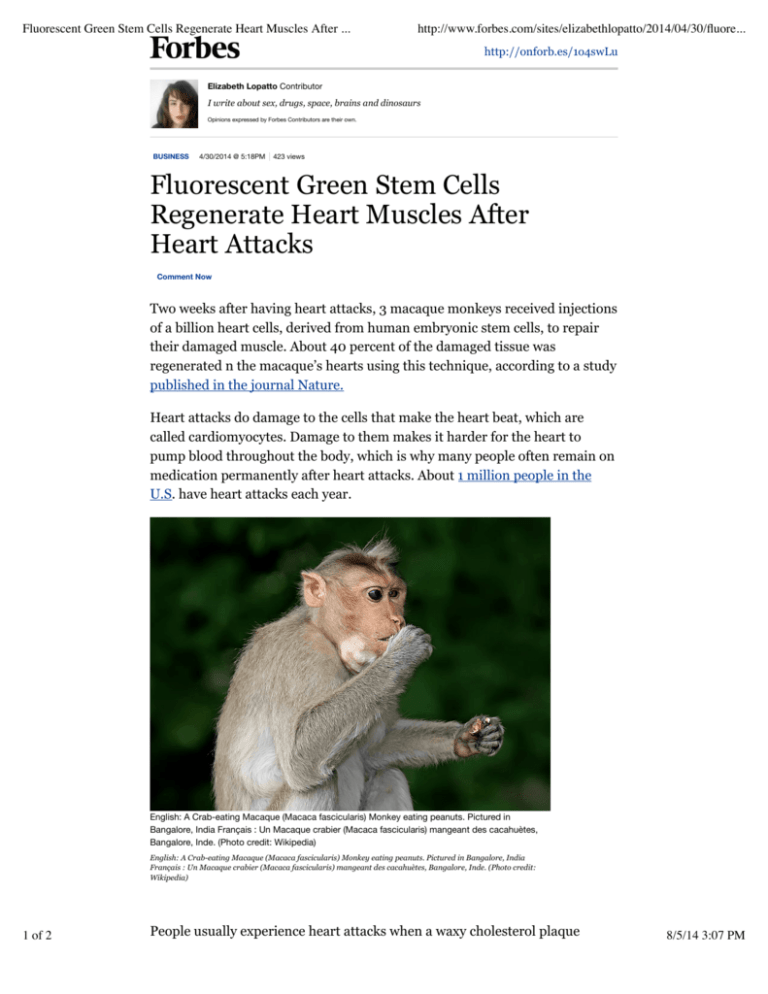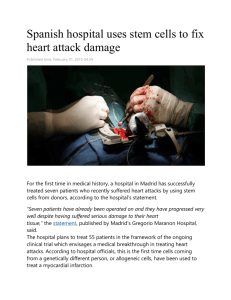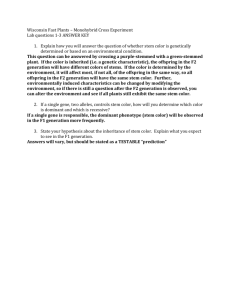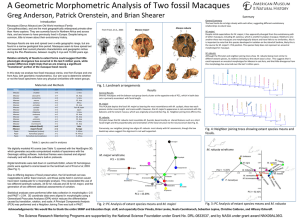
Fluorescent Green Stem Cells Regenerate Heart Muscles After ...
http://www.forbes.com/sites/elizabethlopatto/2014/04/30/fluore...
http://onforb.es/1o4swLu
Elizabeth Lopatto Contributor
I write about sex, drugs, space, brains and dinosaurs
Opinions expressed by Forbes Contributors are their own.
BUSINESS
4/30/2014 @ 5:18PM
423 views
Fluorescent Green Stem Cells
Regenerate Heart Muscles After
Heart Attacks
Comment Now
Two weeks after having heart attacks, 3 macaque monkeys received injections
of a billion heart cells, derived from human embryonic stem cells, to repair
their damaged muscle. About 40 percent of the damaged tissue was
regenerated n the macaque’s hearts using this technique, according to a study
published in the journal Nature.
Heart attacks do damage to the cells that make the heart beat, which are
called cardiomyocytes. Damage to them makes it harder for the heart to
pump blood throughout the body, which is why many people often remain on
medication permanently after heart attacks. About 1 million people in the
U.S. have heart attacks each year.
English: A Crab-eating Macaque (Macaca fascicularis) Monkey eating peanuts. Pictured in
Bangalore, India Français : Un Macaque crabier (Macaca fascicularis) mangeant des cacahuètes,
Bangalore, Inde. (Photo credit: Wikipedia)
English: A Crab-eating Macaque (Macaca fascicularis) Monkey eating peanuts. Pictured in Bangalore, India
Français : Un Macaque crabier (Macaca fascicularis) mangeant des cacahuètes, Bangalore, Inde. (Photo credit:
Wikipedia)
1 of 2
People usually experience heart attacks when a waxy cholesterol plaque
8/5/14 3:07 PM
Fluorescent Green Stem Cells Regenerate Heart Muscles After ...
http://www.forbes.com/sites/elizabethlopatto/2014/04/30/fluore...
breaks open in an artery, causing a blood clot to form. The clot, if large
enough, can totally block blood from flowing through the heart’s arteries. The
muscle ordinarily fed by the blood flow through that artery begins to die. The
dead muscles don’t grow back — instead they are replaced by scar tissue,
which makes it harder for the heart to pump blood. Heart attacks can lead to
other serious conditions, like heart failure, arrhythmias, and death.
The hope of stem cell therapy is replacing the tissue damaged by the heart
attack with new cells that could allow the heart to heal back to something like
normal function. Today’s study suggests that may be possible. The stem-cell
derived heart muscle cells matured and began to beat along with the macaque
heart cells, and after 3 months, they were fully integrated. The scientists were
able to determine this by making sure the human stem cell-derived cells
would express a fluorescent green protein, making them easier to spot. Not
only were they relatively normal, new blood vessels had grown to feed the
heart cells, the first time that’s been seen.
There were some hiccups. First, all the monkeys required
immunosuppressive therapy to prevent their bodies from rejecting the
human cells. And ultrasound studies of the animals’ hearts showed that the
muscle’s ability to pump blood improved in some but not all of the animals.
But the most worrisome thing were episodes of irregular heartbeats that
happened shortly after the stem cell injections. These disappeared after 2 to 3
weeks following the injection, as the stem cells matured.
But the technique, while used in only a few animals, may one day provide
help for heart failure patients, the study authors wrote. Of course, more
research needs to be done.
This article is available online at: http://onforb.es/1o4swLu
2 of 2
2014 Forbes.com LLC™ All Rights Reserved
8/5/14 3:07 PM









